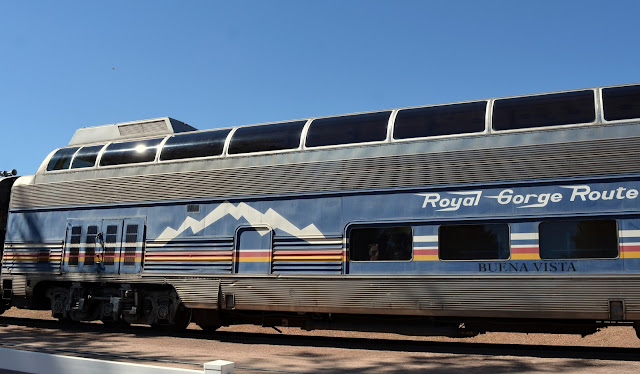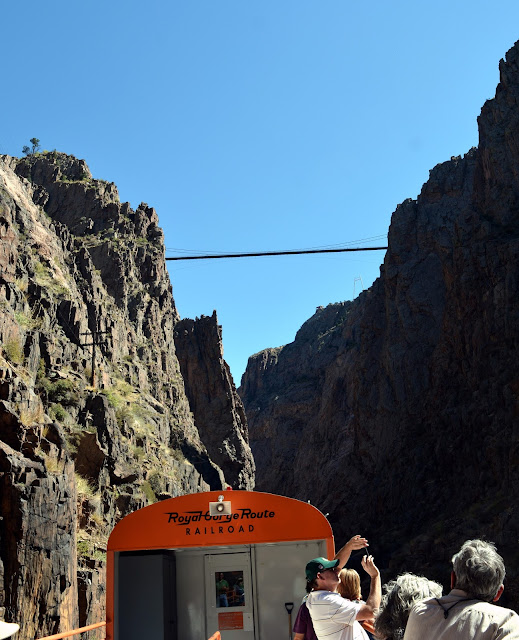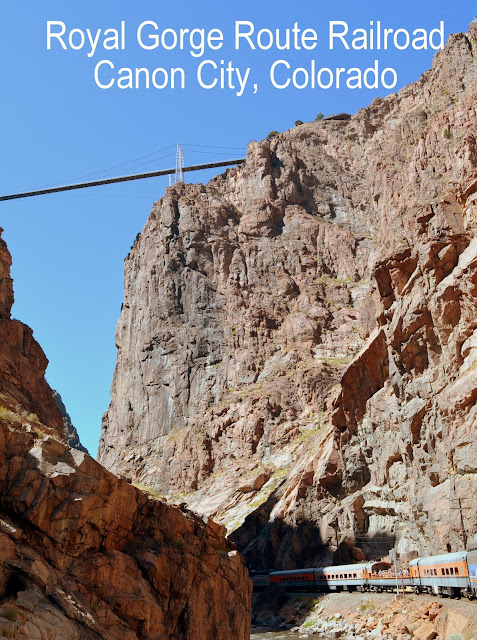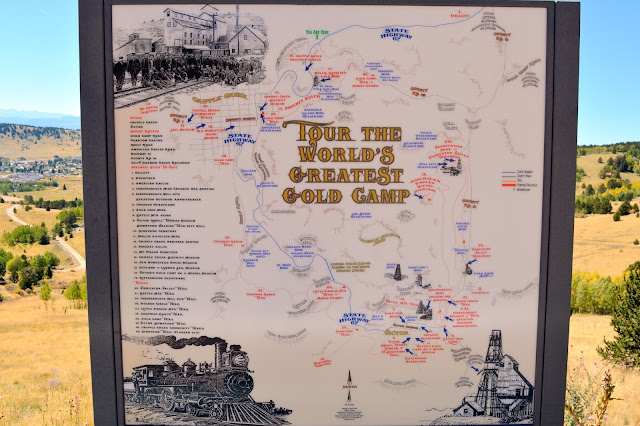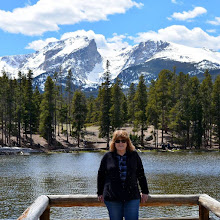Canon City (pronounced Canyon City) is located two miles south of Denver, and 45 minutes west of Colorado Springs. It is known as the "Corrections Capital of the World," as it is the location of nine state and four federal prisons and penitentiaries, which employ thousands of residents of the area. Canon's City was laid out in 1858 during the Pikes Peak Gold Rush, and the first building was built in 1860. The American Civil War interrupted the development of the town for a few years, but afterward, both Confederate and Union soldiers began settling here due to the Homestead Act of 1862.
Please click to enlarge
By the 1870s, Canon City became well know regional trade center. Today, Main Street is full of interesting shops, restaurants, and museums.
I loved looking at the architecture of the well-maintained brick buildings and imagining what the town looked like during its early days.
Please click on this photo to enlarge
A placard along Main Street tells of some of the histories of the town and region.
Please click on this photo to enlarge
Another placard along Main Street describes how Canon City is also known as the "Banana Belt of Colorado" due to its geography. It has a mild climate compared to other regions in Colorado. This enabled early settlers to farm, have orchards, and raise livestock.
I liked the architecture of the 1899 First United Methodist Church, with its red brick walls and copper tower pinnacles. You can read the church's history on its website at this link. The church was not open on my visit, but the church's website has many photos of the inside and of its stained glass windows, as well as its Kimball pipe organ on the church website under its "history" tab.
One of my favorite sights was this charming home, that was built in 1888, in the middle of Canon City's Main Street. I believe there is a business located in it now, but I liked how they kept its cozy home appearance.
All in all, I loved our visit to Canon City and would like to return one day for a longer visit to spend more time in the area.
The main reason for our visit to Canon City, however, was to take a ride on the Royal Gorge Route Railroad! The railroad transits the Royal Gorge on a two-hour scenic and historic train ride, along the most famed portion of the former Denver and Rio Grande Western Railroad. The train departs the Santa Fe Depot in Canon City daily.
The Royal Gorge is considered the "Grand Canyon of the Arkansas River. Approximately six miles long (9.7 km), and one of the deepest canyons in Colorado, the Royal Gorge has a depth of 1,250 feet (380 m). It is also very narrow at points, measuring from 50 feet (15 m) wide at its base, to 300 feet (91 m) at its top. The Arkansas River carves through the granite formations of Fremont Peak and YMCA Mountain, which rise above the north and south trims, to form the canyon
My husband and I purchased tickets for a glass-domed Vista car. The Royal Gorge Route Railroad offers daily departures with several classes of service and dining to choose from, and first-class lunch, dinner, and murder mystery train rides. The interesting history of the original Royal Gorge Route Railroad, which began back in 1879, can be read on their website at this link.
We had lunch while we traveled west, and enjoyed the views from the domed windows.
We planned on going outside to the observation deck car after lunch to enjoy the open-air experience and 360-degree views. Notice how close to the canyon walls the train travels at times!
The train ride is fully narrated. We were told that the wires we saw across the canyon are there to signal the train engineer if there were any rock falls from the top of the canyon. If so, the train would stop so they could be removed from the tracks.
As we dined we enjoyed looking at the views out the doomed windows at the passing scenery.
Our first glimpses of the Royal Gorge Bridge, which traverses the canyon from above was exciting! We knew we would be driving to the Royal Gorge Bridge and walking across the bridge later in the day.
The bridge is 955 feet above the Arkansas River that runs beside the railroad--the highest suspension bridge in the United States, and one of the highest in the world! Built-in 1929, the main span of the bridge between the towers is 880 feet (268 m), and the total length is 1,260 feet (384 m). The width is 18 feet, and the towers are 150 feet (46 m) high. The steel base structure is covered with 1292 wooden planks.
During our ride west. we were also excited to see the whitewater river rafters traveling along the Arkansas River alongside the train!
We continued traveling west until we were out of the canyon to its terminus in Parkdale, Colorado. The train then stopped for a short while...
...and then the train reversed to travel back east towards Canon City.
We went to the open-air car to stand for the trip back so we could enjoy the views.
As the canyon walls grew higher we saw the Royal Gorge Bridge again above us in the distance.
You can get an idea of how narrow the canyon becomes at the bridge point.
If you click on the photo above you can see people looking down at us from the bridge! The train stops for a few minutes at this point on the return trip to allow people to take photos.
My husband and I really enjoyed being outside on the train to see all the views and to take photos of the bridge above.
I was able to take this photo above of what was once an attraction of the Royal Gorge Bridge Park. It was a funicular, that was built in 1931, and brought people down from the Royal Gorge Bridge Park to the bottom of the gorge, where they could stand on the platform to watch the train pass by. The funicular is sadly no longer functioning, due to a fire that occurred in 2013, that damaged the tracks.
I was able to capture a photo of both the bridge above and the train below, traveling through the Royal Gorge Canyon.
We saw the whitewater rafters again at the end of their trip.
We passed remains of old water pipes that once brought water from the river, but are no longer in use.
We were approaching Canon City again, and the end of a wonderful train ride.
Before we left the train station I asked my husband to take this photo of me standing under a nearby very old cottonwood tree. Look how wide it is! It must be hundreds of years old.
We were now on our way to visit the Royal Gorge Bridge and Park--see my next blog post to see more!










